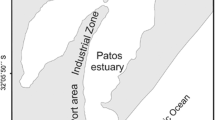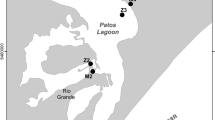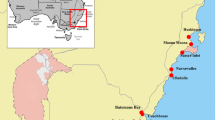Abstract
Arsenic (As), iron (Fe), and manganese (Mn) contents were measured in sediment nodules and associated pore waters obtained from sediment cores collected from a salt marsh on Pólvora Island (southern Brazil). Sediment cores were obtained when brackish water dominated the estuary, at two different environments: an unvegetated mudflat colonized by crabs (Neohelice granulata), and a low intertidal stand vegetated by Spartina alterniflora. We determined the percentage of nodules in each depth interval of the cores, along with redox potential, and As, Fe, and Mn contents of the nodules. The mineralogy of the nodules was investigated, and results showed they are mainly composed by quartz, phyllosilicates, and amorphous Fe–Mn oxides/oxyhydroxides. Pore water results showed that bioturbation by local crabs supports oxygen penetration to depths of ca. 25 cm below the salt marsh surface, with lower Fe contents in pore water associated with the brackish period. However, S. alterniflora growth appears to have a greater impact on sediment geochemistry of Fe, Mn, and possibly As due to sulfate reduction and the associated decrease in pore water pH. Higher Fe concentrations were observed in the pore waters during the period of brackish water dominance, which also corresponded to the S. alterniflora growth season. The study demonstrates that differences in geochemical conditions (e.g., Fe content) that can develop in salt marsh sediments owing to different types of bioirrigation processes (i.e., bioirrigation driven by crabs versus that related to the growth of S. alterniflora) play important roles in the biogeochemical cycling of As.








Similar content being viewed by others
Notes
SiMCosta is a Brazilian Coast Monitoring System, which consists of an integrated network of floating or fixed platforms, with capacity to collect real-time oceanographic and meteorological variables, transmitting them to a processing center at Federal University of Rio Grande (FURG).
References
Álvarez-Iglesias P, Rubio B (2012) Early diagenesis of organic-matter-rich sediments in a ría environment: organic matter sources, pyrites morphology and limitation of pyritization at depth. Estuar Coast Shelf Sci 100:113–123
Berner RA (1981) A new geochemical classification of sedimentary environments. J Sedim Pet. https://doi.org/10.1306/212F7C7F-2B24-11D7-8648000102C1865D
Bhattacharyya R et al (2003) High arsenic groundwater: mobilization, metabolism and mitigation—an overview in the Bengal Delta Plain. Mol Cell Biochem. https://doi.org/10.1023/A:1026001024578
Buschmann J et al (2006) Arsenite and arsenate binding to dissolved humic acids: influence of pH, type of humic acid, and aluminum. Environ Sci Technol. https://doi.org/10.1021/es061057+
Caetano M, Vale C (2002) Retention of arsenic and phosphorus in iron-rich concretions of Tagus salt marshes. Mar Chem. https://doi.org/10.1016/S0304-4203(02)00068-3
Chaillou G et al (2003) The behaviour of arsenic in muddy sediments of the Bay of Biscay (France). Geochim Cosmochim Acta. https://doi.org/10.1016/S0016-7037(03)00204-7
Comans RNJ, Van Dijk CPJ (1988) Role of complexation processes in cadmium mobilization during estuarine mixing. Nature. https://doi.org/10.1038/336151a0
Costa CSB, Marangoni JC, Azevedo AMG (2003) Plant zonation in irregularly flooded salt marshes: relative importance of stress tolerance and biological interactions. J Ecol. https://doi.org/10.1046/j.1365-2745.2003.00821.x
Costa L, Mirlean N, Garcia F (2017) Arsenic environmental threshold surpass in estuarine sediments: effects of bioturbation. Bull Environ Contam Toxicol 98(4):521–524. https://doi.org/10.1007/s00128-016-2024-z
Costa L, Mirlean N, Quintana G, Adebayo S, Johannesson K (2019) Distribution and geochemistry of arsenic in sediments of the world’s largest choked estuary: the Patos Lagoon, Brazil. Estuar Coasts 42:1896–1911
Cross FA, Sunda WG (1978) Relationship between bioavailability of trace metals and geochemical processes in estuaries. In: Wiley ML (ed) Estuarine interactions. Academic Press, New York, p 429
Cullen WR, Reimer KJ (1989) Arsenic speciation in the environment. Chem Rev 89:713–764
D’Incao F et al (1992) Responses of Chasmagnathus granulata Dana (Decapoda: Grapsidae) to salt-marsh environmental variations. J Exp Mar Biol Ecol. https://doi.org/10.1016/0022-0981(92)90095-R
Dacey JW, Howes BL (1984) Water uptake by roots control water table movement and sediment oxidation in short Spartina marsh. Science 224:487–489
Diop C et al (2015) Assessment of trace metals contamination level, bioavailability and toxicity in sediments from Dakar coast and Saint Louis estuary in Senegal, West Africa. Chemosphere. https://doi.org/10.1016/j.chemosphere.2014.12.041
Dixit S, Hering JG (2003) Comparison of arsenic(V) and arsenic(III) sorption onto iron oxide minerals: implications for arsenic mobility. Environ Sci Technol. https://doi.org/10.1021/es030309t
Du Laing G et al (2002) Heavy metal contents (Cd, Cu, Zn) in spiders (Pirata piraticus) living in intertidal sediments of the river Scheldt estuary (Belgium) as affected by substrate characteristics. Sci Total Environ. https://doi.org/10.1016/S0048-9697(01)01025-7
Du Laing G et al (2007) Factors affecting metal concentrations in the upper sediment layer of intertidal reedbeds along the river Scheldt. J Environ Monit. https://doi.org/10.1039/b618772b
Du Laing G et al (2008) Effect of salinity on heavy metal mobility and availability in intertidal sediments of the Scheldt estuary. Estuar Coast Shelf Sci. https://doi.org/10.1016/j.ecss.2007.10.017
Ferreira TO et al (2007) Effects of bioturbation by root and crab activity on iron and sulfur biogeochemistry in mangrove substrate. Geoderma. https://doi.org/10.1016/j.geoderma.2007.07.010
Foster AL, Brown GE Jr, Parks GA (2003) X-ray absorption fine structure study of As(V) and Se(IV) sorption complexes on hydrouse Mn oxides. Geochim Cosmochim Acta 67:1937–1953
Gasparatos D (2013) Sequestration of heavy metals from soil with Fe–Mn concretions and nodules. Environ Chem Lett. https://doi.org/10.1007/s10311-012-0386-y
Gasparatos D et al (2005) Microscopic structure of soil Fe–Mn nodules: environmental implication. Environ Chem Lett. https://doi.org/10.1007/s10311-004-0092-5
Gasparatos D, Massas I, Godelitsas A (2019) Fe–Mn concretions and nodules formation in redoximorphic soils and their role on soil phosphorus dynamics: current knowledge and gaps. CATENA. https://doi.org/10.1016/j.catena.2019.104106
Gong W, Shen J, Reay WG (2007) The hydrodynamic response of the York River estuary to Tropical Cyclone Isabel, 2003. Estuar Coast Shelf Sci. https://doi.org/10.1016/j.ecss.2007.03.012
Gribsholt B, Kostka JE, Kristensen E (2003) Impact of fiddler crabs and plant roots on sediment biogeochemistry in a Georgia saltmarsh. Mar Ecol Prog Ser. https://doi.org/10.3354/meps259237
Guimond JA et al (2020) A physical-biogeochemical mechanism for negative feedback between marsh crabs and carbon storage. Environ Res Lett. https://doi.org/10.1088/1748-9326/ab60e2
Gutiérrez JL et al (2006) The contribution of crab burrow excavation to carbon availability in surficial salt-marsh sediments. Ecosystems. https://doi.org/10.1007/s10021-006-0135-9
Hach C (2007) DR 2800 spectrophotometer user manual. Hach Company. https://doi.org/10.3928/01477447-20101221-06
Haque S, Johannesson KH (2006) Arsenic concentrations and speciation along a groundwater flow path: the Carrizo Sand aquifer, Texas, USA. Chem Geol 228:57–71
Haque S, Ji J, Johannesson KH (2008) Evaluating mobilization and transport of arsenic in sediments and groundwaters of the Aquia aquifer, Maryland, USA. J Contam Hydrol 88:68–84
He YT et al (2010) Geochemical processes controlling arsenic mobility in groundwater: a case study of arsenic mobilization and natural attenuation. Appl Geochem. https://doi.org/10.1016/j.apgeochem.2009.10.002
Hikes ME et al (1999) Molecular phylogenetic and biogeochemical studies of sulfate-reducing bacteria in the rhizosphere of Spartina alterniflora. Appl Environm Microbiol 65:2209–2216
Hines ME, Knollmeyer SL, Tugel JB (1989) Sulfate reduction and other sedimentary biogeochemistry in a northern New England salt marsh. Limnol Oceanogr. https://doi.org/10.4319/lo.1989.34.3.0578
Hines ME, Banta GT, Giblin AE, Hobbie JE (1994) Acetate concentrations and oxidation in salt-marsh sediments. Limnol Oceanogr 39:140–148
Howes BL, Teal JM (1994) Oxygen loss from Spartina alterniflora and its relationship to salt marsh oxygen balance. Oecologia. https://doi.org/10.1007/BF00325879
Howes BL, Howarth RW, Teal JM, Valiela I (1981) Oxidation–reduction potentials in a salt marsh: spatial patterns and interactions with primary production. Limnol Oceanogr 26:350–360
Howes BL, Dacey JWH, Teal JM (1985) Annual carbon mineralization and belowground production of Spartina alterniflora in a New England salt marsh. Ecology 66:595–605
Huerta-Diaz MA, Morse JW (1992) Pyritization of trace metals in anoxic marine sediments. Geochim Cosmochim Acta 56:2681–2702
Iribarne O et al (2000) The role of burrows of the SW Atlantic intertidal crab Chasmagnathus granulata in trapping debris. Mar Pollut Bull. https://doi.org/10.1016/S0025-326X(00)00058-8
Javed MB, Kachanoski G, Siddique T (2014) Arsenic fractionation and mineralogical characterization of sediments in the Cold Lake area of Alberta, Canada. Sci Total Environ. https://doi.org/10.1016/j.scitotenv.2014.08.083
Johannesson KH, Yang N, Trahan AS, Telfeyan K, Mohajerin TJ, Adebayo SB, Akintomide OA, Chevis DA, Datta S, White CD (2019) Biogeochemical and reactive transport modeling of arsenic in groundwater from the Mississippi River delta plain: an analog for the As-affected aquifers of South and Southeast Asia. Geochim Cosmochim Acta 264:245–272
Kalyvas G, Gasparatos D, Massas I (2018) A critical assessment on arsenic partitioning in mine-affected soils by using two sequential extraction protocols. Arch Agron Soil Sci. https://doi.org/10.1080/03650340.2018.1443443
Kirk MF, Holm TR, Park J, Jin Q, Sanford RA, Fouke BW, Bethke CM (2004) Bacterial sulfate reduction limits natural arsenic concentration in groundwater. Geology 32:953–956
Koop-Jakobsen K, Wenzhöfer E (2015) The dynamics of plant-mediated sediment oxidation in Spartina anglica rhizospheres—a planar optode study. Estuar Coasts 38:951–963
Koop-Jakobsen K, Fischer J, Wenzhöfer E (2017) Surevy of sediment oxidation in rhizospheres of the saltmarsh grass—Spartina anglica. Sci Total Environ 589:191–199
Koop-Jakobsen K, Mueller P, Meier RJ, Liebsch G, Jensen K (2018) Plant-sediment interactions in salt marshes—an optode imaging study of O2, pH, and CO2 gradients in the rhizosphere. Front Plant Sci 9:541. https://doi.org/10.3389/fpls.2018.00541
Koretsky CM, Haveman M, Cuellar A, Beuving L, Shattuck T, Wagner M (2008) Influence of Spartina and Juncus on saltmarsh sediments. I. Pore water geochemistry. Chem Geol 255:87–99
Kostka JE, Luther GW (1995) Seasonal cycling of Fe in saltmarsh sediments. Biogeochemistry. https://doi.org/10.1007/BF00000230
Krantzberg G (1985) The influence of bioturbation on physical, chemical and biological parameters in aquatic environments: a review. Environ Poll Ser A Ecol Biol. https://doi.org/10.1016/0143-1471(85)90009-1
Larios R, Fernández-Martínez R, Rucandio I (2012) Comparison of three sequential extraction procedures for fractionation of arsenic from highly polluted mining sediments. Anal Bioanal Chem. https://doi.org/10.1007/s00216-012-5730-3
Lengke MF, Sanpawanitchakit C, Tempel RN (2009) The oxidation and dissolution of arsenic-bearing sulfides. Can Min 47:593–613
Luoma SN, Ho YB, Bryan GW (1995) Fate, bioavailability and toxicity of silver in estuarine environments. Mar Pollut Bull. https://doi.org/10.1016/0025-326X(95)00081-W
Luther GW et al (1992) Seasonal iron cycling in the salt-marsh sedimentary environment: the importance of ligand complexes with Fe(II) and Fe(III) in the dissolution of Fe(III) minerals and pyrite, respectively. Mar Chem. https://doi.org/10.1016/0304-4203(92)90049-G
Manning BA, Goldberg S (1996) Competitive adsorption of arsenate with phosphate and molybdate on oxide minerals. Soil Sci Soc Am J 60:121–131
Marangoni JC, Costa CSB (2012) Short- and long-term vegetative propagation of two Spartina species on a salt marsh in Southern Brazil. Estuar Coasts. https://doi.org/10.1007/s12237-011-9474-7
Marques WC et al (2010) Dynamics of the Patos Lagoon coastal plume and its contribution to the deposition pattern of the southern Brazilian inner shelf. J Geophys Res Oceans 115:10. https://doi.org/10.1029/2010jc006190
Martin JB, Cable JE, Swarzenski PW, Lindenberg MK (2004) Enhanced submarine groundwater discharge from mixing of pore water and estuariine water. Ground Water 42:1000–1010
Martin JB, Cable JE, Jaeger J, Hartl K, Smith CG (2006) Thermal and chemical evidence of rapid water exchange across the sediment–water interface by bioirrigation in the Indian River Lagoon, Florida. Limnol Oceanogr 51:1332–1341
Masscheleyn PH, Delaune RD, Patrick WH (1991) Effect of redox potential and ph on arsenic speciation and solubility in a contaminated soil. Environ Sci Technol. https://doi.org/10.1021/es00020a008
Mendelssohn IA, McKee KL, Patrick WH (1981) Oxygen deficiency in Spartina alterniflora roots: metabolic adaptation to anoxia. Science. https://doi.org/10.1126/science.214.4519.439
Mermillod-Blondin F (2011) The functional significance of bioturbation and biodeposition on biogeochemical processes at the water–sediment interface in freshwater and marine ecosystems. J N Am Benthol Soc. https://doi.org/10.1899/10-121.1
Middelburg JJ, Herman PMJ (2007) Organic matter processing in tidal estuaries. Mar Chem. https://doi.org/10.1016/j.marchem.2006.02.007
Mirlean N, Costa CSB (2017) Geochemical factors promoting die-back gap formation in colonizing patches of Spartina densiflora in an irregularly flooded marsh. Estuar Coast Shelf Sci. https://doi.org/10.1016/j.ecss.2017.03.006
Mirlean N et al (2003) Arsenic pollution in Patos Lagoon estuarine sediments, Brazil. Mar Pollut Bull. https://doi.org/10.1016/S0025-326X(03)00257-1
Mokhtari M et al (2016) Effects of fiddler crab burrows on sediment properties in the mangrove mudflats of sungai sepang, Malaysia. Biology. https://doi.org/10.3390/biology5010007
Moller OO et al (1996) The Patos Lagoon summertime circulation and dynamics. Cont Shelf Res. https://doi.org/10.1016/0278-4343(95)00014-R
Montague CL (2013) The influence of fiddler crab burrows and burrowing on metabolic processes in salt marsh sediments. Estuar Comp. https://doi.org/10.1016/b978-0-12-404070-0.50023-5
Moore JN, Ficklin WH, Johns C (1988) Partitioning of arsenic and metals in reducing Sulfidic sediments. Environ Sci Technol. https://doi.org/10.1021/es00169a011
Neupane G, Donahoe RJ, Arai J (2014) Kinetics of competitive adsorption/desorption of arsenate at the ferrihydrite-water interface. Chem Geol 368:31–38
Nickson RT et al (2000) Mechanism of arsenic release to groundwater, Bangladesh and West Bengal. Appl Geochem. https://doi.org/10.1016/S0883-2927(99)00086-4
Nordstrom DK, Archer DG (2003) Arsenic thermodynamic data and environmental geochemistry. In: Welch AH, Stollenwerk KG (eds) Arsenic in ground water: geochemistry and occurrence. Kluwer, Boston, pp 1–25
Nordstrom DK, Majzlan J, Königsberger E (2014) Thermodynamic properties of arsenic minerals and aqueous species. Rev Min Geochem 79:217–255
Norman White G, Dixon JB (1996) Iron and manganese distribution in nodules from a young Texas vertisol. Soil Sci Soc Am J. https://doi.org/10.2136/sssaj1996.03615995006000040042x
Northrup K, Capooci M, Seyfferth AL (2018) Effects of extreme events on arsenic cycling in salt marshes. J Geophys Res Biogeosci. https://doi.org/10.1002/2017jg004259
O’Day PA et al (2004) The influence of sulfur and iron on dissolved arsenic concentrations in the shallow subsurface under changing redox conditions. Proc Natl Acad Sci. https://doi.org/10.1073/pnas.0402775101
O’Reilly SE, Strawn DG, Sparks DL (2001) Residence time effects of arsenate adsorption/desorption mechanisms on goethite. Soil Sci Soc Am J 65:67–77
Perillo GME (1995) Geomorphology and sedimentology of estuaries. Geomorphol Sedimentol Estuar. https://doi.org/10.1016/0037-0738(95)00149-2
Pierce ML, Moore CB (1982) Adsorption of arsenite and arsenate on amorphous iron hydroxide. Water Res 16:1247–1253
Planer-Friedrich B et al (2007) Thioarsenates in geothermal waters of yellowstone National Park: determination, preservation, and geochemical importance. Environ Sci Technol. https://doi.org/10.1021/es070273v
Quintana G et al (2020) Mercury distributions in sediments of an estuary subject to anthropogenic hydrodynamic alterations (Patos Estuary, Southern Brazil). Environ Monit Assess. https://doi.org/10.1007/s10661-020-8232-3
Ravenscroft P, Brammer H, Richards K (2009) Arsenic pollution: a global synthesis. Arsenic Poll Glob Synth 1:5. https://doi.org/10.1002/9781444308785
Rittle KA, Drever JI, Coldberg PJS (1995) Precipitation of arsenic during bacterial sulfate reduction. Geomicrobiol J 13:1–11
Rosa LC, Bemvenuti CE (2005) Effects of the burrowing crab Chasmagnathus granulata (Dana) on meiofauna of estuarine intertidal habitats of Patos Lagoon, Southern Brazil. Braz Arch Biol Technol. https://doi.org/10.1590/S1516-89132005000200014
Sadiq M (1997) Arsenic chemistry in soils: an overview of thermodynamic predictions and field observations. Water Air Soil Pollut. https://doi.org/10.1023/A:1022135909197
Sanders JG, Osman RW (1985) Arsenic incorporation in a salt marsh ecosystem. Estuar Coast Shelf Sci. https://doi.org/10.1016/0272-7714(85)90083-6
Saunders JA, Pritchett MA, Cook RB (1997) Geochemistry of biogenic pyrite and ferromanganese coatings from a mall watershed: a bacterial connection? Geomicrobiol J 14:203–217
Saunders JA, Lee M-K, Shamsudduha M, Dhakal P, Uddin A, Chowdury MT, Ahmed KM (2008) Geochemistry and mineralogy of arsenic in (natural) anaerobic groundwaters. Appl Geochem 23:3205–3214
Smedley PL, Kinniburgh DG (2002) A review of the source, behaviour and distribution of arsenic in natural waters. Appl Geochem. https://doi.org/10.1016/S0883-2927(02)00018-5
Smith E, Naidu R, Alston AM (1998) Arsenic in the soil environment: a review. Adv Agron. https://doi.org/10.1016/s0065-2113(08)60504-0
Stucker VK et al (2014) Thioarsenic species associated with increased arsenic release during biostimulated subsurface sulfate reduction. Environ Sci Technol. https://doi.org/10.1021/es5035206
Szymański W, Skiba M, Błachowski A (2014) Mineralogy of Fe–Mn nodules in albeluvisols in the carpathian foothills, poland. Geoderma. https://doi.org/10.1016/j.geoderma.2013.11.008
Taylor DI, Allanson BR (1993) Impacts of dense crab populations on carbon exchanges across the surface of a salt marsh. Mar Ecol Prog Ser 101:119
USEPA (1996) Method 3050B—acid digestion of sediments, sludges, and soils. https://doi.org/10.1117/12.528651
Vale C et al (1990) Presence of metal-rich rhizoconcretions on the roots of Spartina maritima from the salt marshes of the Tagus Estuary, Portugal. Sci Total Environ. https://doi.org/10.1016/0048-9697(90)90265-V
van der Zee C, Roberts DR, Rancourt DG, Slomp CP (2003) Nanogoethite is the dominant reactive oxyhydroxide phase in lake and marine sediments. Geology 31:993–996
Velde B, Barré P (2010) Soils, plants and clay minerals: mineral and biologic interactions. Soils Plants Clay Min Min Biol Interact. https://doi.org/10.1007/978-3-642-03499-2
Velde B, Church T (1999) Rapid clay transformations in Delaware salt marshes. Appl Geochem. https://doi.org/10.1016/S0883-2927(98)00092-4
Volkenborn N et al (2016) Bioirrigation in marine sediments. Ref Module Earth Syst Environ Sci. https://doi.org/10.1016/B978-0-12-409548-9.09525-7
Wang JQ et al (2010) Bioturbation of burrowing crabs promotes sediment turnover and carbon and nitrogen movements in an estuarine salt marsh. Ecosystems. https://doi.org/10.1007/s10021-010-9342-5
Wang Y et al (2012) Dynamics of arsenic in salt marsh sediments from Dongtan wetland of the Yangtze River estuary, China. J Environ Sci (China). https://doi.org/10.1016/S1001-0742(11)61048-6
Wilkie JA, Hering JG (1996) Adsorption of arsenic onto hydrous ferric oxide: effect of adsorbate/adsorbent ratios and co-occurring solutes. Colloids Surf A 107:97–110
Wilkin R (2001) Iron sulfide-arsenite interactions: adsorption behavior onto iron monosulfides and controls on arsenic accumulation in pyrite. In: USGS workshop on arsenic in the environment
Wilkin RT, Ford RG (2006) Arsenic solid-phase partitioning in reducing sediments of a contaminated wetland. Chem Geol. https://doi.org/10.1016/j.chemgeo.2005.11.022
Wilkin RT, Wallschläger D, Ford RG (2003) Speciation of arsenic in sulfidic waters. Geochem Trans. https://doi.org/10.1039/b211188h
Wu Y, Li W, Sparks DL (2015) Effect of iron(II) on arsenic sequestration by δ-MnO2: desorption studies using stirred-flow experiments and X-ray absorption fine-structure spectroscopy. Environ Sci Technol. https://doi.org/10.1021/acs.est.5b04087
Yang N et al (2016) High arsenic (As) concentrations in the shallow groundwaters of southern Louisiana: evidence of microbial controls on As mobilization from sediments. J Hydrol Reg Stud. https://doi.org/10.1016/j.ejrh.2015.11.023
Zhu M, Paul KW, Kubicki JD, Sparks DL (2009) Quantum chemical study of arsenic(III, V) adsorption on Mn-oxides: implications for aesenic(III) oxidation. Environ Sci Technol 43:6655–6661
Acknowledgements
This study was supported by a Grant from “Coordenação de Aperfeiçoamento de Pessoal de Nível Superior—Brasil” (CAPES), as well as funds made available by Michael and Mathilda Cochran through the Cochran Family Professorship at Tulane University. We are also grateful to Dr. Deborah Grimm with the Coordinated Instrumentation Facility at Tulane University for assistance with the ICP-MS analyses and to Tanya Goehring for all the help with the XRD analyses.
Author information
Authors and Affiliations
Corresponding author
Additional information
Publisher's Note
Springer Nature remains neutral with regard to jurisdictional claims in published maps and institutional affiliations.
Rights and permissions
About this article
Cite this article
Costa, L., Mirlean, N., Quintana, G. et al. Effects of Bioirrigation and Salinity on Arsenic Distributions in Ferruginous Concretions from Salt Marsh Sediment Cores (Southern Brazil). Aquat Geochem 27, 79–103 (2021). https://doi.org/10.1007/s10498-020-09387-7
Received:
Accepted:
Published:
Issue Date:
DOI: https://doi.org/10.1007/s10498-020-09387-7




